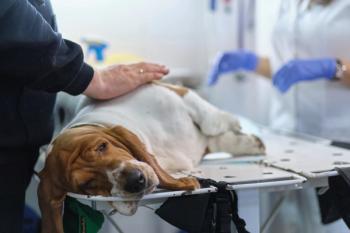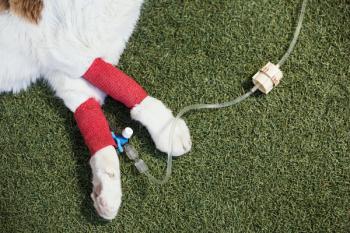
Canine thyroid carcinoma in 4-year-old American bulldog: Radiology perspective
Dr. Lee Emery provides the radiology perspective on this challenging oncology case.
Lee Emery, DVMNearly all imaging modalities play a useful role in the diagnosis, staging and presurgical management of thyroid carcinoma.
Thyroid tumors are typically identified via gross examination or palpation. When a thyroid tumor is found, an ultrasonographic examination and computed tomography (CT) or magnetic resonance imaging (MRI) are the best modalities for further evaluation.1 Cervical radiographs may show a soft tissue mass displacing the trachea; however, radiographs are neither sensitive nor specific for a diagnosing thyroid neoplasia. The best and most common use of plain radiographs is for thoracic metastasis screening.2-4 While thoracic CT is more sensitive than plain radiographs for pulmonary metastasis identification, radiographs are still commonly used even in referral hospitals because of their lower cost, lack of anesthesia requirement and more widespread availability.5
Ultrasonography can be helpful for evaluation of cervical masses as well. Depending on the quality of the machine and experience level of the operator, parameters such as the size and shape of the mass in addition to its location relative to vessels, the trachea, esophagus and other structures can be evaluated. Furthermore, the presence of vascular invasion and origin of the tumor may be determined via ultrasonography.1 It is important to keep in mind that other tumors, such as salivary neoplasia, carotid body neoplasia, lymphoma, as well as other nonneoplastic lesions, can arise from similar locations as thyroid tumors.2,6-9 If a mass is present in the appropriate location for normal thyroid, and normal thyroid tissue is not present, the mass can be determined with reasonable confidence to be of thyroid origin (Figures 6A and 6B).
Figures 6A and 6B. Sonographic images of the right and left thyroid glands in a now 6-year-old castrated male American bulldog (the patient in this case). 6A: A longitudinal image of the normal left thyroid gland (between cursors), which is elongated and homogeneous in echotexture. The markedly hypoechoic nodule in the cranial pole (arrow) likely represents a parathyroid gland. 6B: A longitudinal image of the right thyroid gland, which appears as a large, rounded, heterogeneous and well-encapsulated mass (between cursors).
Definitive diagnosis, however, requires cytologic examination or biopsy. Tissue sampling can be performed via ultrasound guidance, taking into consideration that these tumors are often highly vascular and secondary hemorrage is common. If surgical removal is likely, consultation with a surgeon is recommended before sampling, as local hemorrage may be detrimental to surgical identification of regional vessels and nerves.
The sensitivity and specificity of ultrasonographic examination for diagnosing thyroid carcinoma has been recently reported as 79% and 33%, respectively.1 CT and MRI are both more accurate than ultrasonography, with CT having a sensitivity of 85% and specificity of 100%, and MRI having a sensitivity of 93% and specificity of 67%.1 In addition, it has been reported that CT is 70% sensitive and 100% specific for identifying local invasion by thyroid tumors.2 CT or magnetic resonance angiographic studies may be performed to evaluate local vasculature before surgical excision. Thus, for those cases in which surgical excision is being considered, preoperative advanced imaging is recommended. CT is also used to plan radiation therapy (Figures 7A and 7B).
Figures 7A and 7B. Post-contrast computed tomographic images of the neck from the same dog pictured in Figures 6A and 6B. 7A: Transverse plane through the region of the thyroid glands. The normal left thyroid gland (arrow) is hyperattenuating and lies medial to the left carotid artery. The large heterogeneous mass (star) in the region of the right thyroid gland displaces the right carotid artery medially and the right jugular vein laterally. A normal right thyroid gland is not identified. 7B: Dorsal reconstruction with the mass (star) to the right of the trachea again visible.Both CT and MRI, as well as ultrasonography, are useful in evaluating regional lymph nodes (particularly medial retropharyngeal lymph nodes, which are generally not palpable on physical examination). Enlarged and heterogeneous lymph nodes should raise suspicion for the presence of metastatic disease.
Thyroid scintigraphy, while most often used in cats for diagnosing and treating hyperthyroidism, can be used in dogs to determine whether a mass is thyroidal in origin. Tumors can have a variable appearance of radiopharmaceutical uptake, which is independent of metabolic status (functional vs. nonfunctional).8 Tumors arising from thyroid in the normal location will cause the thyroid gland on the affected side to appear abnormal with varying degrees of enlargement and changes in uptake intensity.7 Ectopic neoplasia may or may not be identifiable via scintigraphy.7,8 Malignancy can be suspected but not definitively determined based on the scintigraphic appearance.7 In select cases, scintigraphy may also be useful for identifying metastatic thyroid nodules either in the cervical soft tissues, cranial mediastinum or pulmonary parenchyma.7
References
1. Taeymans O, Penninck DG, Peters RM. Comparison between clinical, ultrasound, CT, MRI, and pathology findings in dogs presented for suspected thyroid carcinoma. Vet Radiol Ultrasound 2012;54:61-70.
2. Deitz K, Gilmour L, Wilke V, et al. Computed tomography appearance of canine thyroid tumors. J Small Anim Pract 2014;55:323-329.
3. Nadeau ME, Kitchell BE. Evaluation of the use of chemotherapy and other prognostic variables for surgically excised canine thyroid carcinoma with and without metastasis. Can Vet J 2011;52:994-998.
4. Campos M, Ducatelle R, Rutteman G, et al. Clinical, pathologic, and immunohistochemical prognostic factors in dogs with thyroid carcinoma. J Vet Intern Med 2014;28:1805-1813.
5. Armbrust LJ, Biller DS, Bamford A, et al. Comparison of three-view thoracic radiography and computed tomography for detection of pulmonary nodules in dogs with neoplasia. J Am Vet Med Assoc 2012;240:1088-1094.
6. Mai W, Seiler GS, Lindl-bylicki BJ, et al. CT and MRI features of carotid body paragangliomas in 16 dogs. Vet Radiol Ultrasound 2015;56:374-383.
7. Daniel GB, Neelis DA. Thyroid scintigraphy in veterinary medicine. Semin Nucl Med 2014;44:24-34.
8. Rossi F, Caleri E, Bacci B, et al. Computed tomographic features of basihyoid ectopic thyroid carcinoma in dogs. Vet Radiol Ultrasound 2013;54:575-581.
9. Broome MR, Peterson ME, Walker JR. Clinical features and treatment outcomes of 41 dogs with sublingual ectopic thyroid neoplasia. J Vet Intern Med 2014;28:1560-1568.
Newsletter
From exam room tips to practice management insights, get trusted veterinary news delivered straight to your inbox—subscribe to dvm360.





